Earth:Magnesian Conglomerate
From HandWiki
| Magnesian Conglomerate Stratigraphic range: Rhaetian ~208–202 Ma | |
|---|---|
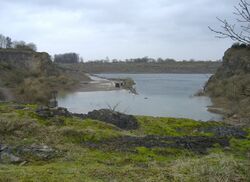 Slickstones Quarry, where an outcrop of the Magnesian Conglomerate is present | |
| Type | Geological formation, fissure fill |
| Underlies | none |
| Overlies | Friars Point Limestone Formation? |
| Lithology | |
| Primary | Breccia |
| Other | Limestone |
| Location | |
| Coordinates | [ ⚑ ] : 51°30′N 2°36′W / 51.5°N 2.6°W |
| Paleocoordinates | [ ⚑ ] 35°54′N 0°48′E / 35.9°N 0.8°E |
| Region | South West England & South Wales |
| Country | |
| Extent | Bristol |
| Type section | |
| Named by | Henry Riley & Samuel Stutchbury |
| Year defined | 1836 |
The Magnesian Conglomerate is a geological formation in Clifton, Bristol in England (originally Avon), Gloucestershire and southern Wales, present in Tytherington, Durdham Down, Slickstones Quarry and Cromhall Quarry.
It dates back to the Rhaetian stage of the Late Triassic,[1][2] although it may be as old as the Norian stage of the Late Triassic and as young as the Hettangian stage of the Early Jurassic.[citation needed]
The Magnesian Conglomerate was first discovered in autumn 1834 and was studied in 1836 by Henry Riley and Samuel Stutchbury.[3]
The Avon Fissure Fill is often paired with the Magnesian Conglomerate.[1]
Vertebrate paleofauna[1]
| Taxon | Species | Presence | Notes | Images |
|---|---|---|---|---|
| Actinopteri[4] | Indeterminate[4] | Geographically present in Durdham Down.[4] | A tooth.[4] | |
| Agnosphitys[2][5] | A. cromhallensis[2][5] | Geographically present in Avon, England (now Bristol).[2] | Its remains include a left ilium (holotype) and a left maxilla, astragalus and humerus (referred specimen).[2] | 
|
| Agrosaurus[6][2] | A. macgillivrayi[6][2] | Geographically present in Avon, England (now Bristol). Originally believed to have been found in Cape York Peninsula, Queensland (Australia ).[2] | A tibia, a claw and some other fragments.[2] | |
| Archosauria[7] | Indeterminate[7] | Geographically present in Durdham Down.[4] | Five specimens, including jaw fragments, caudals, and a scapulocoracoid.[7] | |
| Archosauromorpha[4] | Indeterminate[4] | Geographically present in Durdham Down.[4] | A fragment of a small tooth.[4] | |
| Asylosaurus[2][8] | A. yalensis[2][8] | Geographically present in Avon, England (now Bristol).[2][9] | Dorsal vertebrae, ribs, gastralia, a shoulder girdle, humeri, a partial forearm, and a hand; additional bones from the neck, tail, pelvis, arm and legs that may represent the same individual.[8][2] | 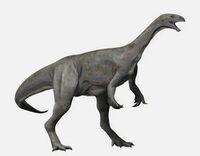
|
| Chimaeriformes[10] | Indeterminate[10] | Geographically present in Bristol.[2] | Indeterminate remains.[10] | |
| Clevosaurus[11] | C. hudsoni[11] | Geographically present in Gloucestershire.[2] | Partial cranial and post-cranial skeleton (holotype).[11] | 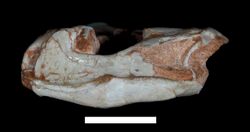
|
| Crinoidea[10] | Indeterminate[10] | Geographically present in Bristol.[2] | Reworked from older Carboniferous sediments (Friars Point Limestone Formation).[12] | |
| Cryptovaranoides[13] | C. microlanius[14] | Geographically present in Slickstones Quarry.[15] | Holotype (partial skeleton) and referred isolated remains.[16] | 
|
| Diphydontosaurus[10] | D. avonensis[10] | Geographically present in Bristol.[2] | Complete to near-complete specimens.[10] | 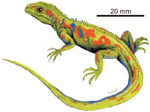
|
| Herrerasauria?[8] | Indeterminate[8] | Geographically present in Durdham Down.[4] | 3 indeterminate specimens.[8] | |
| Hwiccewyrm[17] | H. trispiculum[17] | Geographically present in Slickstones Quarry.[17] | Several specimens comprising a partial skeleton.[17] Discovered during the 1970s and listed as cf. Hypsognathus by Whiteside et al. (2016).[18] | 
|
| Hybodontiformes?[4] | Indeterminate[4] | Geographically present in Bristol.[2] | Indeterminate remains.[4] | |
| Gyrolepis[19] | Indeterminate[19] | Geographically present in Bristol.[2] | Indeterminate remains.[19] | |
| Kuehneosauridae[4] | Indeterminate[4] | Geographically present in Durdham Down.[4] | Rib that may instead be an ulna belonging to Terrestrisuchus.[4] | |
| Lissodus[4] | L. minimus[4] | Geographically present in Bristol.[2] | Teeth.[4] | 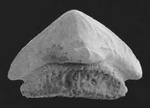
|
| Ornithischia[8] | Indeterminate[8] | Geographically present in Durdham Down.[4] | Indeterminate specimen.[8] | |
| Palaeosaurus[2][8] | P. cylindrodon[2][8] | Geographically present in Avon, England (now Bristol) and Bristol.[2] | Two teeth (one destroyed in 1940).[2] | 
|
| Phytosauria[4] | Indeterminate[4] | Geographically present in Durdham Down.[4] | Two teeth previously assigned to Mystriosuchinae.[4] | |
| Planocephalosaurus[20][21] | P. robinsonae[20][21] | Geographically present in Bristol.[2] | Skull (holotype) and a tooth.[20] | |
| Plateosauria[22] | Indeterminate[22] | Geographically present in Durdham Down.[4] | 22 partial specimens.[22] | |
| Rhomphaiodon[4] | R. minor[4] | Geographically present in Bristol.[2] | Teeth, including the subsidiary cusp of one tooth.[4] | |
| Rileyasuchus[2][23][24] | R. bristolensis[2][23][24] | Geographically present in Bristol.[2] | Two vertebrae and a humerus.[2] | |
| Sauropodomorpha[8] | Indeterminate[8] | Geographically present in Durdham Down.[4] | Indeterminate remains.[8] | |
| Sphenosuchia[4] | Indeterminate[4] | Geographically present in Durdham Down.[4] | A right femur initially named as Thecodontosaurus costa.[4] | |
| Terrestrisuchus[4][10] | T. gracilis and indeterminate[4][10] | Geographically present in Bristol and South Wales.[2] | Indeterminate and partial remains.[4][10] | 
|
| Theropoda[2] | Indeterminate[2] | Geographically present in Avon, England (now Bristol) and Bristol.[2] | A tooth, and a tibia that was once allied with Thecodontosaurus.[2][8] Possibly similar to Pendraig milnerae.[25] | |
| Thecodontosaurus[2] | T. antiquus[2] | Geographically present in Avon, England (now Bristol) and Bristol.[2] | Partial cranial and postcranial remains (holotype is a lower jaw).[2] | 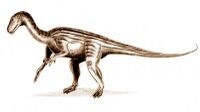
|
See also
- List of dinosaur-bearing rock formations
- List of fossiliferous stratigraphic units in England
References
- ↑ 1.0 1.1 1.2 Magnesian Conglomerate in the Paleobiology Database
- ↑ 2.00 2.01 2.02 2.03 2.04 2.05 2.06 2.07 2.08 2.09 2.10 2.11 2.12 2.13 2.14 2.15 2.16 2.17 2.18 2.19 2.20 2.21 2.22 2.23 2.24 2.25 2.26 2.27 2.28 2.29 2.30 2.31 2.32 2.33 2.34 2.35 2.36 2.37 2.38 Weishampel et al., 2004, pp. 521–525
- ↑ Riley & Stutchbury, 1836
- ↑ 4.00 4.01 4.02 4.03 4.04 4.05 4.06 4.07 4.08 4.09 4.10 4.11 4.12 4.13 4.14 4.15 4.16 4.17 4.18 4.19 4.20 4.21 4.22 4.23 4.24 4.25 4.26 4.27 4.28 4.29 4.30 4.31 4.32 4.33 4.34 4.35 4.36 Foffa, D.; D. I. Whiteside; P. A. Viegas, and M. J. Benton. (2014). Vertebrates from the Late Triassic Thecodontosaurus-bearing rocks of Durdham Down, Clifton (Bristol, UK). Proceedings of the Geologists' Association 125. 317–332.
- ↑ 5.0 5.1 Nicholas C. Fraser, Kevin Padian, Gordon M. Walkden and A. L. M. Davis, 2002. Basal dinosauriform remains from Britain and the diagnosis of the Dinosauria. Palaeontology. 45(1), 79-95.
- ↑ 6.0 6.1 H. G. Seeley. (1891). On Agrosaurus macgillivrayi (Seeley), a saurischian reptile from the N.E. coast of Australia. Quarterly Journal of the Geological Society of London 47:164-165
- ↑ 7.0 7.1 7.2 WHITESIDE, D. I.; MARSHALL, J. E. A. (2007-09-17). "The age, fauna and palaeoenvironment of the Late Triassic fissure deposits of Tytherington, South Gloucestershire, UK". Geological Magazine 145 (1): 105–147. doi:10.1017/s0016756807003925. ISSN 0016-7568. http://dx.doi.org/10.1017/s0016756807003925.
- ↑ 8.00 8.01 8.02 8.03 8.04 8.05 8.06 8.07 8.08 8.09 8.10 8.11 8.12 8.13 8.14 Galton, Peter (2007). "Notes on the remains of archosaurian reptiles, mostly basal sauropodomorph dinosaurs, from the 1834 fissure fill (Rhaetian, Upper Triassic) at Clifton in Bristol, southwest England". Revue de Paléobiologie. 26 (2): 505–591.
- ↑ Riley H and Stutchbury S (1836a) "A description of various remains of three distinct saurian animals discovered in the autumn of 1834, in the Magnesian Conglomerate on Durdham Down, near Bristol". Geological Society of London, Proceedings, 2 (45): 397-399.
- ↑ 10.00 10.01 10.02 10.03 10.04 10.05 10.06 10.07 10.08 10.09 10.10 Mussini, G.; Whiteside, D. I.; Hildebrandt, C.; Benton, M. J. (2020). "Anatomy of a Late Triassic Bristol fissure: Tytherington fissure 2". Proceedings of the Geologists' Association 131 (1): 73–93. doi:10.1016/j.pgeola.2019.12.001. Bibcode: 2020PrGA..131...73M.
- ↑ 11.0 11.1 11.2 W. E. Swinton. (1939). A new Triassic rhynchocephalian from Gloucestershire. ''Annals and Magazine of Natural History: Zoology, Botany, and Geology'' '''4''':591-59
- ↑ Keeble, Emily; Whitestide, David I.; Benton, Michael J. (2018). "The terrestrial fauna of the Late Triassic Pant-y-ffynnon Quarry fissures, South Wales, UK and a new species of Clevosaurus (Lepidosauria: Rhynchocephalia)". Proceedings of the Geologists' Association 129 (2): 99–119. doi:10.1016/j.pgeola.2017.11.001. Bibcode: 2018PrGA..129...99K. https://research-information.bristol.ac.uk/files/149334438/PantyF_MS_revised.pdf.
- ↑ Whiteside, D. I.; Chambi-Trowell, S. A. V.; Benton, M. J. (2022). "A Triassic crown squamate" (in en). Science Advances 8 (48): eabq8274. doi:10.1126/sciadv.abq8274. ISSN 2375-2548. PMID 36459546. Bibcode: 2022SciA....8.8274W. https://www.science.org/doi/10.1126/sciadv.abq8274.
- ↑ Whiteside, D. I.; Chambi-Trowell, S. A. V.; Benton, M. J. (2022). "A Triassic crown squamate" (in en). Science Advances 8 (48): eabq8274. doi:10.1126/sciadv.abq8274. ISSN 2375-2548. PMID 36459546. Bibcode: 2022SciA....8.8274W. https://www.science.org/doi/10.1126/sciadv.abq8274.
- ↑ Whiteside, D. I.; Chambi-Trowell, S. A. V.; Benton, M. J. (2022). "A Triassic crown squamate" (in en). Science Advances 8 (48): eabq8274. doi:10.1126/sciadv.abq8274. ISSN 2375-2548. PMID 36459546. Bibcode: 2022SciA....8.8274W. https://www.science.org/doi/10.1126/sciadv.abq8274.
- ↑ Whiteside, D. I.; Chambi-Trowell, S. A. V.; Benton, M. J. (2022). "A Triassic crown squamate" (in en). Science Advances 8 (48): eabq8274. doi:10.1126/sciadv.abq8274. ISSN 2375-2548. PMID 36459546. Bibcode: 2022SciA....8.8274W. https://www.science.org/doi/10.1126/sciadv.abq8274.
- ↑ 17.0 17.1 17.2 17.3 Butler, R. J.; Meade, L. E.; Cleary, T. J.; McWhirter, K. T.; Brown, E. E.; Kemp, T. S.; Benito, J.; Fraser, N. C. (2023). "Hwiccewyrm trispiculum gen. et sp. nov., a new leptopleuronine procolophonid from the Late Triassic of southwest England". The Anatomical Record. doi:10.1002/ar.25316. PMID 37735997.
- ↑ Whiteside, D. I., Duffin, C. J., Gill, P. G., Marshall, J. E. A., & Benton, M. J. (2016). The Late Triassic and Early Jurassic fissure faunas from Bristol and South Wales: Stratigraphy and setting. Palaeontologia Polonica, 67, 257–287.
- ↑ 19.0 19.1 19.2 Romano, Carlo; Koot, Martha B.; Kogan, Ilja; Brayard, Arnaud; Minikh, Alla V.; Brinkmann, Winand; Bucher, Hugo; Kriwet, Jürgen (February 2016). "Permian-Triassic Osteichthyes (bony fishes): diversity dynamics and body size evolution". Biological Reviews 91 (1): 106–147. doi:10.1111/brv.12161. PMID 25431138.
- ↑ 20.0 20.1 20.2 Fraser, N.C. (November 1982). "A New Rhynchocephalian from the British Upper Trias". Palaeontology 25 (4): 709–725. https://www.palass.org/sites/default/files/media/publications/palaeontology/volume_25/vol25_part4_pp709-725.pdf.
- ↑ 21.0 21.1 Fraser, N.C.; Walkden, G.M. (August 1984). "The postcranial skeleton of the Upper Triassic sphenodontid Planocephalosaurus robinsonae". Palaeontology 27 (3): 575–595. https://www.palass.org/sites/default/files/media/publications/palaeontology/volume_27/vol27_part3_pp575-595.pdf.
- ↑ 22.0 22.1 22.2 P. Galton. (2005). Basal sauropodomorph dinosaur taxa Thecodontosaurus Riley & Stutchbury, 1836, T. antiquus Morris, 1843 and T. caducus Yates, 2003: their status re: humeral morphs from the 1834 fissure fill (Upper Triassic) in Clifton, Bristol, UK. Journal of Vertebrate Paleontology 25(3, suppl.):61A
- ↑ 23.0 23.1 von Huene, F. (1902). Überischt über die Reptilien der Trias. Geologische und Paläontologie Abhandlungen, Neu Folge 8:97-156. [German]
- ↑ 24.0 24.1 Kuhn, O. (1961). Die Familien der rezenten und fossilen Amphibien und Reptilien. Meisenbach:Bamberg, 79 p.
- ↑ "Pendraig milnerae, a new small-sized coelophysoid theropod from the Late Triassic of Wales". Royal Society Open Science 8 (10): Article ID 210915. 2021. doi:10.1098/rsos.210915. PMID 34754500. Bibcode: 2021RSOS....810915S.
Bibliography
- Foffa, D.; D. I. Whiteside; P. A. Viegas, and M. J. Benton. 2014. Vertebrates from the Late Triassic Thecodontosaurus-bearing rocks of Durdham Down, Clifton (Bristol, UK). Proceedings of the Geologists' Association 125. 317–332.
- Weishampel, David B.; Peter Dodson, and Halszka Osmólska (eds.). 2004. The Dinosauria, 2nd edition, 1–880. Berkeley: University of California Press. Accessed 2019-02-21. ISBN:0-520-24209-2
- Riley, H., and S. Stutchbury. 1836. A description of various fossil remains of three distinct saurian animals discovered in the autumn of 1834 in the Magnesian Conglomerate on Durdham Down near Bristol. Proceedings of the Geological Society 2. 397–399.
Further reading
- Riley, H. and Stutchbury, S. 1840. A description of various fossil remains of three distinct saurian animals recently discovered in the Magnesian Conglomerate near Bristol Transactions of the Geological Society of London 5, 349–357
- W. Buckland. 1824. Reliquiæ Diluvianæ; or, Observations on the Organic Remains Contained in Caves, Fissures, and Diluvial Gravel, and on Other Geological Phenomena, Attesting the Action of an Universal Deluge. Second Edition. John Murray, London 1-303
External links
 |


